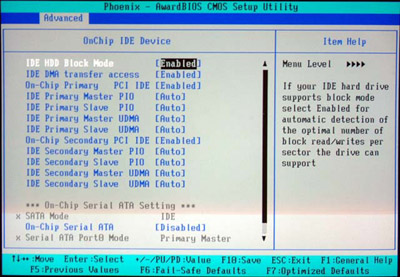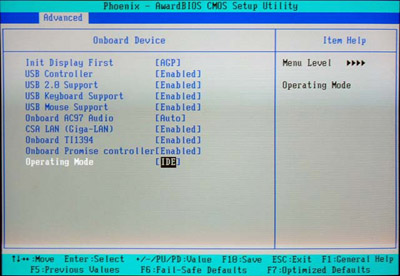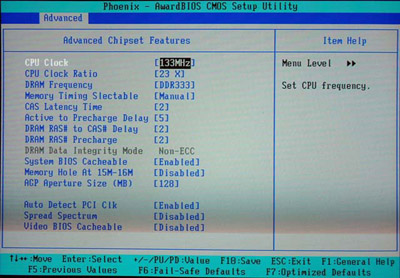Asus PC-DL Deluxe: 875 with Dual Xeons
by Wesley Fink on September 6, 2003 12:06 AM EST- Posted in
- Motherboards
Asus PC-DL: BIOS and Overclocking
Asus uses Award BIOS in the “drop-down menu” arrangement found on many Asus boards. If you’re familiar with the Asus implementation of Award and AMI BIOS on their other motherboards, then you will be very comfortable with the BIOS arrangement. It’s a little different than the more common Award arrangement, but all the information and choices are there — they’re just arranged a little differently.
Menu choices are across the top and as you navigate across, the dropdown menu’s change. Many of the menus that are standalone in traditional Award BIOS are nested under other headings here.

The Advanced menu provides access to 3 sub-menus for adjusting IDE-SATA and other on-Chip devices and ports.

The On-Chip IDE device section is where adjustments are made to IDE, and where Serial ATA and SATA RAID are setup.

Onboard Device provides control options for USB, audio, CSA LAN, firewire, and the Promise controller.

Memory timings, FSB, and Multiplier Ratios are adjusted in the Advanced Chipset Menu. Our Xeons allowed multiplier adjustment down, but we did not have options to set values higher than the stock 23X.

CPU FSB can be adjusted from stock 133 to 165, but there are no adjustments for Voltage or a “Fixed PCI/AGP” setting. This severely limits overclocking of the Dual-Xeon board.

Asus is well-known for their power control and adjustment options, and the PC-DL also has a complete selection of power on/off/save options. This is also the menu section with a submenu for Hardware Monitoring or PC Health.

The boot menu becomes very important if you have many drives or arrays connected to the PC-DL. You can manually select your preferred boot devices in this menu.
BIOS adjustments are complete as far as they go, but with Asus targeting the PC-DL to the Gamer and Enthusiast market, we really expected more options for overclocking the board. Right now, an option to lock the PCI/AGP bus would allow the current FSB range to be fully used. With the ability to use the same memory as the fastest Pentium 4 boards on the market, we certainly would appreciate voltage options for RAM and memory ratios to allow a wider range of memory speeds.
FSB Overclocking Results
Asus suggests this board is a great match to the 10,000 RPM Western Digital Raptor SATA drives in a SATA RAID 0 array. This would allow a cost-effective, but high-speed, workstation or small-server configuration. That sounded like a good idea, so the plan was to test the Asus PC-DL with dual Raptors in a SATA Raid 0. We know the SATA drives will not operate at any PCI setting other that 33, so we assumed Asus must have set up the board with an “always-on” PCI/AGP lock.It turned out we were wrong in our assumption. When you install a SATA Raid on the Asus PC-DL, all overclocking options are automatically turned off. We have contacted Asus for more information on whether this will be fixed in a future BIOS upgrade. When we have more information on this, we will post it here. Just be aware that at least for now, there will be no overclocking options at all if you use SATA drives on the Asus PC-DL.
Since we really wanted to see what the PC-DL could do with overclocking, we abandoned the plan to test with a fast SATA RAID array, and settled for benchmarking with an IDE drive. As soon as SATA is disabled in BIOS, the missing overclocking options, as limited as they are, magically reappear.
The following setup was used on the Asus PC-DL for FSB overclocking:
| Front Side Bus Overclocking Testbed | ||
| Processor: | Two Intel Xeon 3.06GHz (533FSB) with 1MB Cache |
|
| CPU Voltage: | Default | |
| Cooling: | Two Swiftech MCX603 with Two Panaflo high-output 80mm fans | |
| Memory: | 2x512MB Mushkin 3500 Level II | |
| Hard Drive: | Maxtor 120GB 7200 RPM (8MB Buffer) | |
| Power Supply: | Vantec Stealth 470W 24-pin ATX and 8-pin 12V |
|
While we could boot at overclocked speeds as high as the 160 (640FSB), the highest stable overclock we could achieve was 144 (576FSB or 3.3GHz). After having equipped the Dual Xeons with the great cooling capabilities of Dual Swiftech MCX603 heatsinks, we were very disappointed in this overclock. We are convinced this limitation is because of the lack of a PCI/AGP lock option in the BIOS, and it is probably a bus-speed limitation of our ATI Radeon 9800 PRO.
IT Professionals will probably find the very idea of overclocking a dual-Xeon board unthinkable, but please keep in mind that Asus told us they are targeting this board to gamers and computer enthusiasts. These 2 groups want to squeeze the absolute best performance out of their hardware. They will be very disappointed in current options for tweaking this board, and the limited overclocking that is possible compared to Pentium 4 875 boards.
Looking at the clock generators and voltage regulators on board, it certainly appears Asus can provide much wider tweaking and overclocking options in future BIOS upgrades. As it now is shipping, however, overclocking options are severely limited.










29 Comments
View All Comments
Anonymous User - Monday, September 8, 2003 - link
Xeon DPs are still at the 533 right now. Xeon MPs are worse off at just 400. Faster Xeons are just around the corner though.sprockkets - Monday, September 8, 2003 - link
Aren't the Xenons at 667FSB? But as usual, they share the bandwidth, which is really bad since they crave bandwidth, but good for memory access. But clearly the HT idea is faster.Running though at 800 maybe really too hard to do, or not ?
Anonymous User - Monday, September 8, 2003 - link
Remember Xeons were built for the server market where stability is king. Intel knew this and this is why the 533MHz FSB has stuck around so long. As Intel rolls out more 800Mhz FSB chipsets and P4 chips the 800Mhz FSB Xeon should follow several months later. The same process could be seen back when the 400Mhz FSB Xeons were around.Anonymous User - Monday, September 8, 2003 - link
Well don't take my word for it, wait for the results yourself and then you can admit you are a fool! Clueless kids looking to argue... What a waste of time.Anonymous User - Sunday, September 7, 2003 - link
Is HyperThreading enabled for those Dual Xeons?Anonymous User - Sunday, September 7, 2003 - link
@13 "it would not improve performance enough to even be competitive"lol... what reviews have you been reading? the extra fsb makes a huge difference! THG overclocked the Xeons by 7 mhz and averaged somewhere around 4-4.5% performance increase! That's pretty damn significant. Even bringing the Xeons up to 667 FSB would make it a very good performer!
Anonymous User - Saturday, September 6, 2003 - link
Don't believe everything you read... ESPECIALLY from Intel. Go read THG's review and *maybe* you'll have a better appreciation for why Intel ain't likely to release a 800 MHS FSB Xeon any time soon and it would not improve performance enough to even be competitive when a 2.0 Gig. Opteron/A64 blows the doors off a dual 3.06 Gig. Xeon. If you wanna feel bad... look at how the dual Opteron beats up on a dual Xeon.Anonymous User - Saturday, September 6, 2003 - link
Read the news -- Intel has said it WILL produce 800Mhz FSB Xeons (when is a bit of a question: the last report I read over a month ago said Q1 '04 but they may have moved it up -- that's what this article seems to imply).Anonymous User - Saturday, September 6, 2003 - link
There are technical reasons why the Xeon can't do 800 MHz FSB. Tom's Hardware went into some of the reasons in their dual Xeon test where Opteron also smoked the Xeon even with the new L3 cache. The reality is that Intels current processors have just become obsolete with Opteron and A64. The benches for A64 will show equal or better performance for a single CPU than Opteron. For multi-processor systems above (4) CPUs the Opteron has an advantage over the A64. As the benches show Intel simply has nothing to compete in either the desktop or server segments and soon the A64 will be available in laptop to so Intel needs to get it in gear. Needless to say all Opteron/A64 CPUs will run both 32-bit and 64-bit O/S's. Linux has been available and Windoze will be available soon. AMD has definitety made a qunatum performance leap over Intel this time, no doubt.Anonymous User - Saturday, September 6, 2003 - link
Remember that server boards have to go through more stringent evaluation then desktop boards. I don't think Intel even considers 800Mhz FSB stable enough for their Xeons yet, and it's a shame. There is only so much increasing your L2 cache size can do for you. I don't think you can use 2.4Cs on this board even if you could find a socket adapter -- remember the 'overclocking settings' were limited to 133->165 (that's almost the 667Mhz FSB that Intel might move the Xeon to soon). So you'd be underclocking it by at least 17%, and at that point why bother? That's if you can find some video card that will take a 79Mhz AGP speed -- good luck with that.